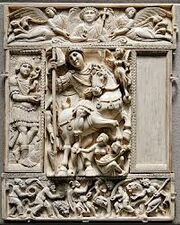
The 5 separate pieces of the Barberini Ivory Carving put together
Brief Identification[]
This object is known as Barberini Ivory. It was made during the first half of the sixth century in the city of Constantinople. It consists of five ivory plaques, which are fitted together. The main plaque is located in the middle and is believed to be depicting Emperor Justinian after a victory. This historical artifact currently resides in Paris France at the Louvre.
Technical Evaluation[]
Plaques were commonly carved from ivory, which is a bone-like substance found on animals that have tusk, like elephants, rhinos, and walruses [See Krzyszkowska 209-212 1988]. The techniques for carving ivory have been around for generations dating all the way back to the Bronze Age and have changed very little. To carve plaques out of Ivory sculptors would use common tools like a hammer and a chisel. The only advancement sculptures might have in the technology used for carving would be stronger and more durable tools. This carving is carved in the style known as late Theodosian, representing the emperor as the triumphant victor.[1] Ivory is a very expensive material; during the sixth century, the majority of the ivory would have been coming out of Africa either by trade or conquest. Today the ivory plaques of Barberini Ivory rest in Paris France at the Louvre. [http://www.flickr.com/photos/28433765@N07/7985397251/] "Williamson still refers to the Barberini Ivory Carving to be perhaps the most celebrated of the late antique ivories." [See Cutler 249-253]
Local Historical Context[]
The Barberini Ivory is a Byzantine ivory leaf from an imperial diptych dating from Late Antiquity. [2] The carving is believed to be depicting the Justinian, leader of the Byzantine Empire crushing Slavic and Persian enemies.[3]This was a chaotic and dangerous time for the Byzantine Empire, who was surrounded by enemies after the collapse of the Western Roman Empire. This carving was made to show the greatness of Justinian and the Byzantine Empire and their ability to overcome obstacles. Although the common people of the time were farmers or street merchants and had no huge rule in society this carving depicting strength and virtue would make them be proud to be a part of such a great and powerful empire.
World-Historical Significance[]
There is a broad area from which ivory sculptures in the world have come from. Both the East and the West have produced ivory carvings, but there is no reliable information on were the artistic cenere they were produced is. [4] Constantinople was a central trading hub between the Middle East, Europe, and Africa, and had a variety of different types of carvings and other forms of art.
The top plaque of Barberini Ivory has a depiction of Jesus Christ on it. That is significant since Constantinople was a city in the middle of all the makor western trading routes. Making artwork like this and being in such a central location made it easier to spread the ideas of Christianity. Much of the artwork during this time had a Godly or Christ-like a reference in them. In the end, Carvings like Barberini Ivory and others allowed the Byzantine Empire on a large scale to strongly influence their people and surrounding areas.
Bibliography[]
The Burlington Magazine , Vol. 135, No. 1078 (Jan, 1993), pp. 48-49
Cutler, Anthoney. West 86th: A Journal of Decorative Arts, Design History, and Material Culture , Vol. 18, No. 2 (Fall-Winter 2011), pp. 249-253
Krzyszkowska. The Annual of the British School at Athens , Vol. 83, (1988), pp. 209-234
Kinney, Dale, and Cutler, Anthoney. American Journal of Archaeology , Vol. 98, No. 3 (Ju, 1994), pp. 457-480
Qantara, Barberini Ivory http://www.qantara-med.org/qantara4/public/show_document.php?do_id=751&lang=en
|
Byzantine art and architcture, Images for Humanity http://www.fotopedia.com/albums/wMMmm1vo270/entries/dxk8zna1vsQ Barberini, http://employees.oneonta.edu/farberas/ARTH/arth212/barberini_ivory.htm Diptych Barberini, Paris Louvre, http://www.flickr.com/photos/28433765@N07/7985397251/ Byzantine Ivories, The Metropolitan Museum of Art, http://www.metmuseum.org/toah/hd/ivor/hd_ivor.htm Ivory Carving, Architecture, Mosaics and Imperial Christian Art, https://www.boundless.com/art-history/late- antiquity/architecture-mosaics-and-imperial-christian-art/ivory-carving/
|